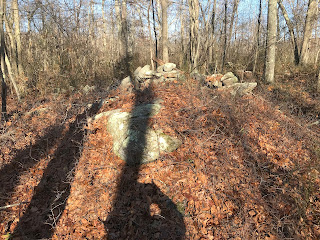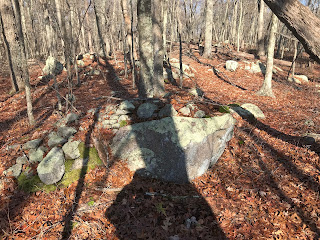I was forwarded a Facebook exchange on the subject of "aggressive" rock pile grooming. By "aggressive" I mean removing all the organic material that has accumulated on top of a stone structure - leaving only bare ("sweaty") rocks. I occasionally see pictures of piles that have been groomed like that and I refuse to publish the pictures and write the sender that they should stop doing that. This is not the only sort of vandalism that is done under the umbrella of destroying things in order to preserve them. Anyway, the following, from Mark Starr, is extremely well said:
When you strip all of that material from the boulders you
leave all those stones highly vulnerable to sliding off the next time a branch
hits it or ice and rain coat it, or even from squirrels hopping across them,
especially the ones on slopes as in your photos. All that moss and lichen not
only help define their antiquity, but act as glue, holding them in place. What
you learn by doing that is almost nothing, as the stones have undoubtedly
shifted already over time, and their position can be modeled without removing
everything holding them in place. You also ruin the possibility for modern
dating techniques such as OSL to be used. It may satisfy your personal
curiosity but ruins the science to be done in the future. Nearly everything you
show are simply stones placed by human hands randomly on the boulder. The significance
was the act of placing them. While some were undoubtedly placed in significant
patterns, nearly all of your photos simply show random placement, which is
obvious without removing moss, lichen, leaf clutter, etc.. If your photos
survive, all we will have is what they once looked like. I really wish you
would stop doing this to satisfy personal curiosity. Removing everything around
the stones no matter how carefully or respectfully still leaves them highly
vulnerable, and non-destructive documentation techniques exist that don't cause
this harm. I can always tell where you've been in the woods, and the cairns
stripped of their patina give modern hikers the impression they should get in
on the fun by adding to them or restacking them. I know you mean well and are
doing it for what you feel are the right reasons, but you are nonetheless
leaving a trail of destruction the future won't be able to study. Science isn't
served in any way by showing the stripped surfaces you leave behind.
[here some back-and forth, then continuing....]
I am only interested in the long-term preservation of the
stonework. As XXX is working on his own property he can do as he wishes. I
don't think that gives him the right to do what he wants wherever he goes.
Right or wrong, even the tribes don't have a say in the matter off their own
property. So that's one thing.
The more important thing is still the long term preservation
of these objects. Archaeologists were taking cairns apart for years trying to
find the prize inside. They were eventually stopped from doing this because
first off, there was no prize inside, and secondly, no real science was being done.
They learned the lesson at least If you clean off 12,000 boulders to see
randomly placed stones on top and you can't figure out what's going on by then,
perhaps you should stop doing it, at least until you can figure it out. In most
cases, all you can do is speculate with the info supposedly gathered. what
little has been learned from all of this was largely known a long time ago.
Yes, a ton of speculation has been produced. So that's the second thing. Even
archeologists leave much of any site undone for the future - for more advanced
techniques and technology to come along and do a better job. How many times
have we regretted past archaeological digs that destroyed evidence they didn't
think possible to analyse? Is 12,000 examples not enough?
Thirdly, there are ways of gathering what little info that
has been gathered without resorting to what is being done. There is a
difference in removing branches, sticks, and this year's dropped leaves from a
cairn (or any other structure) and stripping off all of the materials as seen
in his photos. Everything that may have been measurable and provided clues in
the future has been erased. They never thought of studying seeds or pollen in
the past because they couldn't imagine the future. What don't we know now that's
just around the corner? DNA is now pulled from once unimaginable sources. Those
opportunities are now gone with his work. Okay, you want to try and figure out
something. How many chances do you get? If what you are learning is that people
placed stones on boulders you can do that without destructive techniques. If
its buried, and you absolutely must know there are buried stones there and how
they were placed, yes, you might have to uncover them. But what protected them
for you to get that opportunity, and more importantly can it be done in other
ways that leave them in the best state currently possible for the future? I
think we should always be looking to preserve as much as we can for the future.
With these particular cases, the ratio of knowledge gained to possible loss is
unreasonable. We can scan these structures and get far more information about
them than he is collecting without touching them.
So is this practice causing harm? Simply looking at the
photos he posts makes it more than obvious. All of the glue that has held them
together - moss, lichen, leaf clutter, etc., etc., is now gone. Just look at
the stones on the sloping edges and tell me they are less vulnerable than they
were. Yes, they were falling apart even with the glue, but now it will be far
more rapid. My original post was because I came home that day having seen this
in action. Someone had cleared out a vertical split in a boulder and after the
last big rain storm we had you could see all of the washout of materials at the
bottom. (I'm not saying YYY did this - it could be a copycat now that it's
okay to do this). The split had been filled with many small stones that were
now distributed all over the ground. Had the glue still been there so would
they. Now I can see all of the stones that were once there, but I could have
seen a whole lot of them by pulling a few leaves. What did I learn? There were
a lot of types of stones placed in the split. I pretty much knew that without
having to see them spilled out, and would have known that by pulling a few
leaves. The future will not know this. So there are photos of it. And when the
hard drive fails that stored them goes or someone tosses it out who didn't
think they were important then what? I've worked in museums and I know what
happens to ephemeral information. I worked for a museum for 20 years producing
3d models of objects in the collection. They paid a lot of money for me to do
so, and shortly after I left they threw out my computer as IT didn't know what
it was!
So what are the proper channels he's gone through? I know
Doug Harris has repeatedly said in public not to touch them, as have the other
tribal preservation officers I know. If he would let me with who has cleared
him to do this that represents all the tribes I'd be satisfied and I can take
it up with them. But in the long run, what is the goal? He states he is trying
to hopefully reacquaint the tribes with their ancestors stone creations (see
his full quote above). A nobel cause I'm sure, but does what he's doing do
anything more than simply photographing them and sending those to them do? I
know nothing I say or write is going to change what he does. Its always easy to
justify what we want to do - just look at the fate of the indigenous peoples
since the arrival of Europeans. Now however, with the internet, everyone and
who feels they need to know what's under those leaves now has a license to do
the same, and it doesn't bode well for these structures future.





























